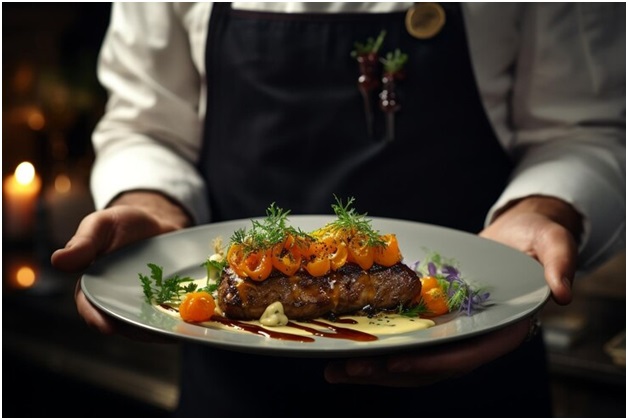Step into the world of Michelin Star fine dining, where culinary excellence takes centre stage. A Michelin Star is the pinnacle of recognition, reserved for restaurants that elevate the dining experience to extraordinary heights. These establishments are a celebration of quality ingredients, meticulously crafted dishes, and unparalleled service, promising an unforgettable culinary journey. From the timeless elegance of classic French cuisine to the avant-garde creations of modern fusion, Michelin Star fine dining guarantees nothing less than the best in gastronomic indulgence.
The history of Michelin Star Fine Dining traces back to 1900 when the visionary Michelin brothers, Andre and Edouard, established their tire company, Michelin & Cie. In a move that would redefine the culinary landscape, they introduced an annual guidebook for motorists, featuring maps and information about local establishments. The iconic Michelin Guide, born in 1926, awarded stars based on the quality of cuisine—one star for good cooking, two stars for excellent cooking, and the coveted three stars for establishments offering extraordinary cuisine deemed “worth a special journey.”
Today, the Michelin Guide continues to be a compass for discerning diners, with nearly 3100 active starred restaurants worldwide. These establishments are meticulously evaluated on criteria such as technique, precision, and, most importantly, the ability to deliver the best Michelin Star fine dining experience.
Michelin stars are the pinnacle of culinary recognition, bestowed upon restaurants that excel in cuisine and service. The Michelin Guide, published by the esteemed French tire company Michelin, awards stars to signify levels of excellence. One star denotes “very good,” two stars signify “excellent,” and three stars represent an establishment that is “exceptional” or “worth a special journey.” These stars are earned annually, reinforcing a commitment to maintaining the highest standards.
Inspectors evaluate restaurants on five critical criteria: the quality of ingredients, mastery of flavour and cooking techniques, the personality of cuisine, value for money, and consistency between visits. The atmosphere also plays a crucial role in the evaluation process. Since its inception in 1926, the Michelin Guide has expanded globally, covering regions such as Belgium, Luxembourg, Great Britain, Ireland, Italy, and beyond.
Achieving a Michelin star is the ultimate accolade for any restaurant, requiring a commitment to excellence in all aspects of the dining experience. The stringent criteria encompass not only the quality and creativity of the cuisine but also the professionalism of the service and the ambience. From the perfect execution of complex dishes to the warmth of hospitality, every element contributes to the coveted Michelin Star recognition.

Dining at a Michelin Star restaurant is a privilege that comes with numerous benefits. These establishments are celebrated for their exceptional cuisine and impeccable service. A Michelin Star restaurant, recognized by the Michelin Guide, signifies a commitment to excellence. Whether awarded one, two, or three stars, these establishments represent some of the best in the world. The benefits include the opportunity to savour exceptional cuisine crafted by talented chefs who prioritize unique flavours and top-quality ingredients. The dining experience extends beyond the plate, encompassing a luxurious atmosphere and attentive service that elevates the entire occasion.
For restaurants aspiring to the pinnacle of culinary recognition, the journey to receive a prestigious award is riddled with challenges. Meeting the rigorous criteria set by competitions like Michelin stars requires chefs to balance traditional gastronomic standards with innovative creations that push boundaries. Service staff must exhibit professionalism and exceptional customer service to impress judges with their hospitality skills. Beyond the kitchen, restaurateurs face administrative tasks, ensuring that applications are submitted accurately and within deadlines. The pursuit of distinction demands a multifaceted approach that goes beyond culinary mastery.
In the world of luxury dining, Michelin stars symbolize culinary excellence and innovation. Renowned chefs and establishments with the highest number of stars are revered for their exceptional quality and dedication to pushing the boundaries of gastronomy. From Guy Savoy’s three-starred haven in Paris to Alain Ducasse’s two-starred Mediterranean retreat in Monte Carlo, these culinary maestros redefine the art of fine dining.
In conclusion, Michelin-star fine dining is not just a meal; it’s a unique and luxurious experience that transcends expectations. The journey through the world of Michelin stars promises a level of quality unmatched elsewhere—from the exceptional service and carefully curated atmosphere to the exquisite cuisine. While the cost of a Michelin-star meal may be substantial, it pales in comparison to the unparalleled and unforgettable experience that awaits those seeking a culinary journey like no other. For connoisseurs and enthusiasts alike, Michelin-star fine dining is an investment in the extraordinary.
